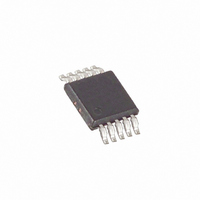MAX1823BEUB+T Maxim Integrated Products, MAX1823BEUB+T Datasheet - Page 11

MAX1823BEUB+T
Manufacturer Part Number
MAX1823BEUB+T
Description
IC SW USB DUAL W/FB 10-UMAX
Manufacturer
Maxim Integrated Products
Datasheet
1.MAX1823BEUBT.pdf
(13 pages)
Specifications of MAX1823BEUB+T
Applications
USB, Peripherals
Current - Supply
50µA
Voltage - Supply
4 V ~ 5.5 V
Operating Temperature
-40°C ~ 85°C
Mounting Type
Surface Mount
Package / Case
10-MSOP, Micro10™, 10-uMAX, 10-uSOP
Lead Free Status / RoHS Status
Lead free / RoHS Compliant
Fault blanking allows the MAX1823 to handle USB loads
that may not be fully compliant with the USB specifica-
tions. USB loads with additional bypass capacitance
and/or large startup currents can be successfully pow-
ered even while protecting the upstream power source.
No fault is indicated if the switch is able to bring up the
load within the 20ms blanking period.
IN, INA, and INB provide the power for all control and
charge-pump circuitry. All three IN_ pins must be con-
nected together externally. The input-voltage slew rate
should be less than 0.2V/µs to prevent erroneous
FAULT_ indications. This condition should not occur
under normal USB applications.
Connect a capacitor from IN_ to ground to limit the input
voltage drop during momentary output short-circuit con-
ditions. A 0.1µF ceramic capacitor is required for local
decoupling; higher capacitor values further reduce the
voltage drop at the input (see the Typical Application
Circuit (Figure 1)). When driving inductive loads, a larg-
er capacitance prevents voltage spikes from exceeding
the MAX1823’s absolute maximum ratings.
Table 1. MAX1823 Current Limiting and Fault Behavior
Output short circuit
(V
Output overload current
(V
Thermal fault
(T
J
OUT
OUT
> +160°C)
< 1V)
> 1V)
CONDITION
Applications Information
______________________________________________________________________________________
Input Power Source
•
•
•
•
•
•
•
•
•
An output short circuit ramps the current to I
blanking timer turns on, FAULT_ stays high, and the output current pulses at 0.35A
Removing the short circuit before the 15ms short-circuit blanking timeout period allows the
next ramped current pulse to soft-start the output. The FAULT_ flag stays high.
A short circuit exceeding 15ms to 20ms forces FAULT_ low at 20ms, enables autoreset
mode, and sources 25mA at the output.
An output voltage above 0.5V for 20ms resets the switch, turns on the output, and forces
FAULT_ high.
An output overload regulates the current at I
overload is removed, a thermal fault occurs, or the 20ms continuous current-limit timeout
period is reached.
An overcurrent condition still present at 20ms forces FAULT_ low, enables autoreset, and
sources 25mA at the output.
An output voltage above 0.5V for 20ms resets the switch, turns on the output, and forces
FAULT_ high.
A junction temperature of +160°C immediately forces FAULT_ low (the blanking timer does
not apply to thermal faults) and turns off the switch. The junction cooling 15°C removes the
thermal fault condition, enables autoreset mode, and sources 25mA at the output. FAULT_
remains low while a thermal fault condition is present.
An output voltage above 0.5V for 20ms resets the switch, turns on the output, and forces
FAULT_ high.
Input Capacitor
Dual USB Switch with Fault
Blanking and Autoreset
Place a 1µF or greater capacitor at each output for noise
immunity. When starting up into very large capacitive
loads, the switch pulses the output current at 0.35A
until the output voltage rises above 1V, then the capacitor
continues to charge at the full 0.9A current limit. There is
no limit to the output capacitor size, but to prevent a start-
up fault assertion, the capacitor must charge up within
the fault-blanking delay period. Typically, starting up into
a 330µF or smaller capacitor does not trigger a fault out-
put. In addition to bulk capacitance, small-value (0.1µF or
greater) ceramic capacitors improve the output’s
resilience to electrostatic discharge (ESD).
A wide variety of devices (mice, keyboards, cameras,
and printers) can load the USB port. These devices com-
monly connect to the port with cables, which can add an
inductive component to the load. This inductance causes
the output voltage at the USB port to ring during a load
step. The MAX1823 is capable of driving inductive loads,
but avoids exceeding the device’s absolute maximum rat-
ings. Usually the load inductance is relatively small, and
the MAX1823’s input includes a substantial bulk capaci-
tance from an upstream regulator as well as local bypass
capacitors, limiting overshoot. If severe ringing occurs
due to large load inductance, clamp the MAX1823’s out-
put below 6V and above -0.3V.
MAX1823 BEHAVIOR
SHORT
LIM
(0.9A), and FAULT_ stays high until the
in 2ms to 3ms, the switch shuts off, the
Driving Inductive Loads
Output Capacitor
RMS
.
RMS
11




